Shopify Starter Plan Review: Simple, Cost-Effective for Beginners
As a seasoned entrepreneur, I’ve had the opportunity to explore various ecommerce platforms, and the Shopify Starter Plan stands out for its unique focus on social commerce. For just $5 a month, this plan simplifies online selling, allowing me, content creators, and influencers to connect with customers through popular social media and messaging apps.
If you want to establish your online presence, I highly recommend the Shopify Starter Plan to start your ecommerce journey. In this article, I will discuss its features, benefits, and pricing. I will also compare it with other plans and show you how to set up your Shopify products using Linkpop, Shopify’s link-in-bio tool. Let’s get started!
My Experience with the Shopify Starter Plan
| Shopify Starter Plan Pricing | $5 Monthly |
| My Rating | 4.8 Out of 5 Stars |
| Ease of Use | Easy to sign up and has a beginner-friendly interface without overwhelming advanced skills |
| Customer service | Excellent support whenever I needed to solve problems |
| Marketing, SEO, and Product tools | I rated these features as basic functionalities that primarily focus on social selling and lack advanced ecommerce features |
| Linkpop integration | FREE. The Shopify Starter plan supports me in creating shoppable landing pages by Linkpop to connect my social media pages, media links, and web-based documents. |
| Free trial | Get 3 days FREE, then the first month for only $1 |
I’ll share my experience with the plans, highlighting the key features and ratings for aspiring entrepreneurs and small business owners.
Shopify Starter Plan: Pros & Cons
| Pros | Cons |
|---|---|
|
|
What is the Shopify Starter Plan?
The Shopify Starter Plan, replacing the previous Shopify Lite Plan, is the cheapest plan, focusing on a quick and easy way to create a simple online store and sell online products without requiring complicated tools or high prices.
Exclusive Offer: Get Shopify 33 days for just $1 + The Online Store Starter Kit
Start your 3-day free trial, and enjoy your first month of Shopify for $1 plus the premium package designed especially for new Shopify merchants!
Who is the Shopify Starter Plan Best For?
Based on my experience and customer reviews, the Starter Shopify Plan is best for:
- Individuals or businesses that primarily sell limited quantities of products through social media platforms like Instagram, Facebook, and Twitter
- Bloggers, content creators, and social media influencers looking to sell merchandise or digital products
- Merchants with existing non-Shopify websites built on platforms like WordPress, Wix, or Squarespace
- Solopreneurs and side hustlers operating independently or managing a side business
How much does the Shopify Starter Plan cost?
Subscription fees
In my experience, the Starter Shopify Plan is priced straightforwardly at a flat monthly fee of $5 after the standard 3-day Shopify free trial, with no hidden costs. However, annual subscriptions have no discounts, which is a drawback of using the plan.
One notable aspect is the transaction fees. The Starter Plan charges a 5% fee, which is higher than other Shopify plans. This can be significant when I have a high sales volume, making me consider upgrading to other Shopify subscription plans to save costs in the long run.
Its transaction fees are detailed:
- Online credit card rates: 5% + $0.30
- In-person credit card fees: 5%
- For credit cards issued outside of the United States, Shopify will charge an additional 1% fee per transaction.
While the Starter Plan is budget-friendly for entering eCommerce, its higher transaction fees can add up quickly for growing businesses. So, carefully consider your sales projections and weigh the benefits against the costs before committing to this plan.
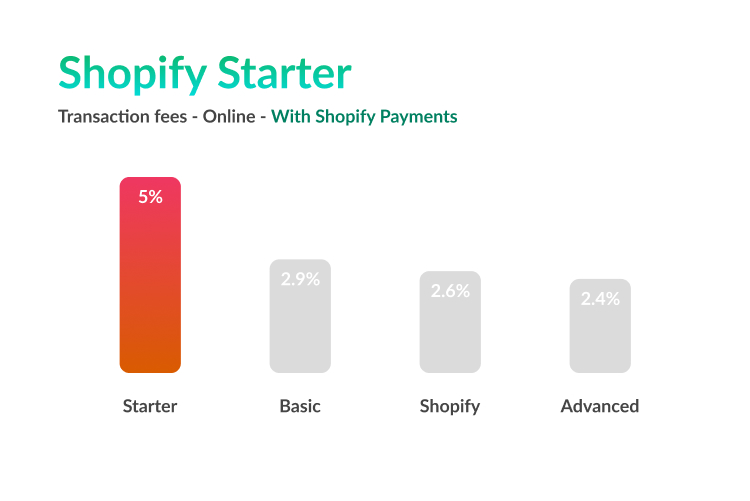
Tips: How to check Shopify Pricing for your store location
Shopify has different prices and transaction fees for different countries and regions. If you want to sell to a specific country, it is recommended that you locate your Shopify store there. However, make sure you check Shopify pricing for that country first.
Note: To be sure, you can turn on your VPN (if you are outside your target country) or off the VPN (if you are inside your target country).
Shopify Starter Plan Features
During my hands-on exploration of the Shopify Starter plan demo, I was pleasantly impressed by the array of features available even with the free trial. Here’s a glimpse of what I discovered you can access with this plan:
Linkpop
I found the Linkpop page to be a versatile tool for showcasing my brand. It allowed me to customize a landing page with social media links, essential business details, and eye-catching images.
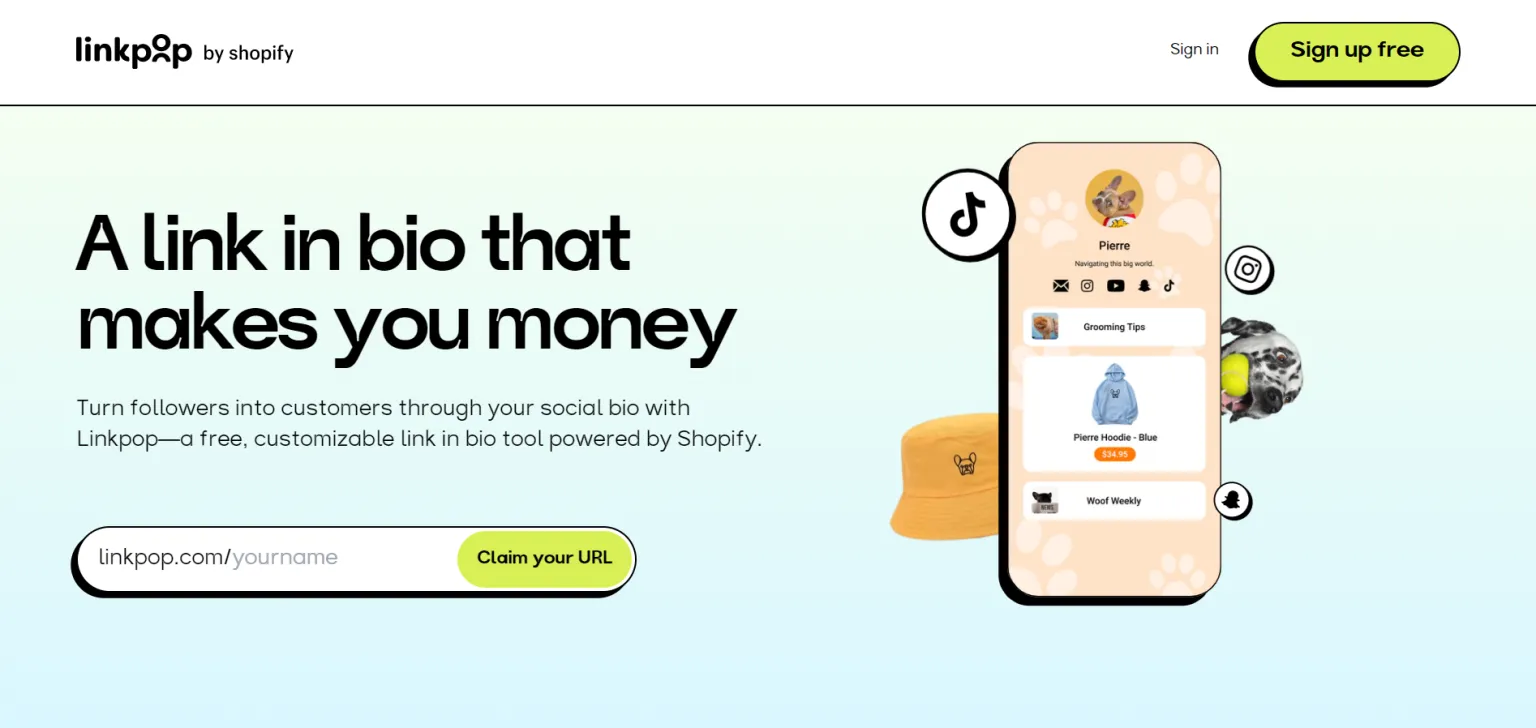
The real game-changer was integrating the Linkpop link into my social media bios, especially on TikTok and Instagram. This simple step significantly amplified my brand’s reach and drove more traffic to my products.
Effective Selling Features on Social Media
The Shopify Starter plan is perfect for direct social media selling. I found it extremely easy to manage products, upload photos, write descriptions, and set prices, which I could share product links across Facebook, Twitter, and Snapchat. I’d rate this feature 5/5 for its simplicity and effectiveness.

When someone clicks on my shared product link, they are taken directly to the product page. This seamless process, where customers can check out, add more items, and complete their purchase using Shopify Checkout, receives a 4.5/5 rating from me.
I also appreciate the ability to do in-person selling using Shopify POS Lite. By downloading the Shopify POS app on my smartphone or tablet, I was ready to start selling face-to-face. I’d rate this feature 4/5 for its convenience and ease of use.
Sales Analytics & Order Management
The Analytics feature provides vital insights into my business’s performance by showcasing critical metrics like total sales, a detailed sales breakdown, top-selling products, and order history. This tool allows me to compare recent sales values to previous periods, assess the effectiveness of different sales channels, and track my average order value.
For example, I noticed a significant increase in sales for a new product after a social media campaign, which I could track and confirm through the analytics.
Additionally, comparing recent sales to previous periods allowed me to evaluate the impact of seasonal promotions. The ability to assess different sales channels helped me determine that Instagram was my most effective platform for driving sales, which influenced my marketing strategy. Overall, I’d rate this feature 5/5 for its comprehensive and actionable insights.
Customer Service & Security
Customer service
As a hosted eCommerce solution, the Starter plan offers robust security measures to protect my customers’ data. Here are the steps it takes to bolster security:
- PCI Compliant: The platform adheres to the Payment Card Industry Data Security Standards (PCI DSS). This ensures that credit card transactions are processed securely.
- SSL Certificates: Using SSL (Secure Socket Layer) certificates, data moving between the user’s browser and Shopify’s server is encrypted. This secures sensitive details like credit card information.
- Two-factor Authentication: To further deter unauthorized access, this feature offers an added security layer to my store.
Security
Being part of the Shopify ecosystem, the Starter plan Shopify I gained access to comprehensive customer support.
- Online Documentation: Shopify’s Help Center boasts many articles and tutorials, assisting in everything from store setup to inventory management.
- Community Forum: With Shopify’s vibrant community forum, I can share experiences and seek guidance from peers who’ve faced similar challenges.
- Email and Chat Support: For more specific concerns, users can directly contact the support team through email or live chat.
Watch Out: Under the Shopify Starter plan, I couldn’t build a full standalone store, but I could still brand my pages effectively. To do this, I go to my Shopify dashboard, navigate to “Settings,” and select “Brand.” Here, I can set up the following:
- My logo and brand colors (primary and secondary)
- A cover image that showcases my brand on profile pages and apps
- My slogan or brand statement (up to 80 characters)
- A short description of my business for bios and listings (up to 150 characters)
- Social links (Facebook, Twitter, Pinterest, Instagram, TikTok, Tumblr, Snapchat, YouTube, Vimeo)
The only theme available under this plan is the Spotlight theme, which I can use to set up my branding options. While I can’t customize the theme extensively, setting up these branding elements allows me to maintain a cohesive and professional look.
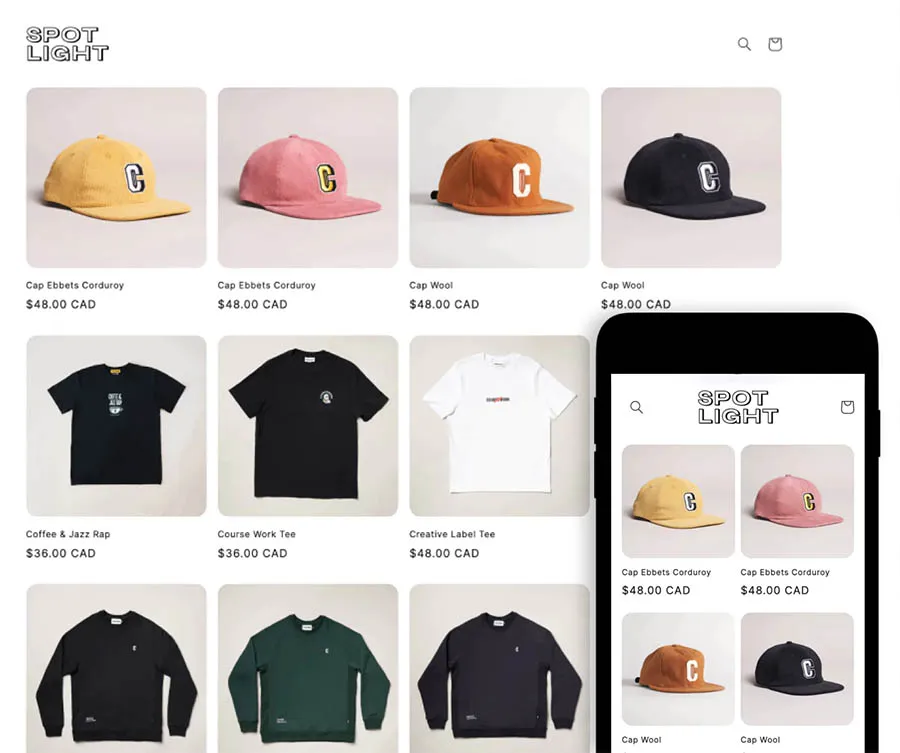
Additionally, my store address is under a Shopify subdomain (myshop.myshopify.com). When someone visits this URL, they see my online storefront with all my branding elements in place. This setup has allowed me to establish a recognizable brand presence, even with the limitations of the Starter plan.
Features similar to other Shopify plans
While the Starter Shopify Plan is more basic compared to other Shopify plans, it still shares several key features standard across the Shopify ecommerce platform:
- Unlimited Products Listing Capacity
- Unlimited Bandwidth
- Brand Assets Management
- Fraud Analysis Feature:
- Manual Order Creation
- Discount Codes
- Abandoned Cart Recovery
- Analytics
- Finance Reports
- 24/7 Customer Support
- Shopify Order Management
- +60 Types of Reports
- Duties and Import Taxes
- 3 Markets for Additional Regional Customization
In addition to Shopify, store owners can choose from other free ecommerce website builders like Squarespace, Wix, Weebly, and Big Cartel.
Shopify Starter Plan Tutorial (Step by Step)
After experiencing the Starter plan, here is my step-by-step guide on signing up for a Shopify Starter Plan and using it to sell my products.
Step 1: Sign up for a Shopify Starter Plan
If you don’t have a Shopify store yet, the first step is to create one.
-
Go to Shopify.com and select the “Start free trial” option, which offers a 3-day free trial to get started.
-
Next up, complete a brief survey, or skip this step by clicking on “Skip All.”
-
Choose your business location from the provided options and click the “Next” button to proceed.
-
Then, wait a few minutes while Shopify sets up your new Shopify store.
-
Once your online store is ready, it’s time to go for a Shopify pricing plan. To do it, you can click the “Pick a plan” button at the top of the screen and select “Choose Starter.”
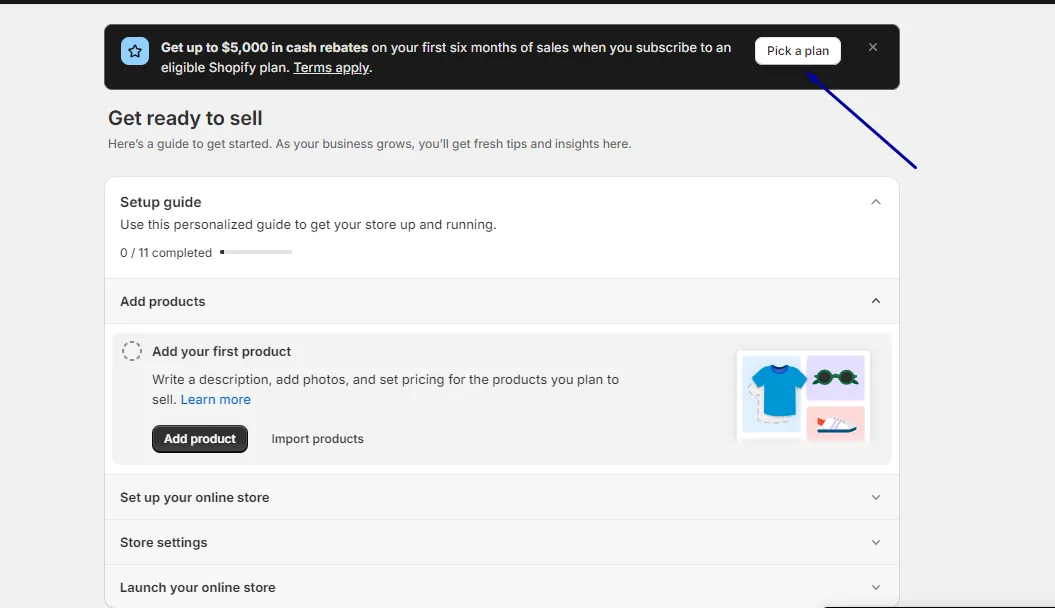
- You will pay $1 only for the next month
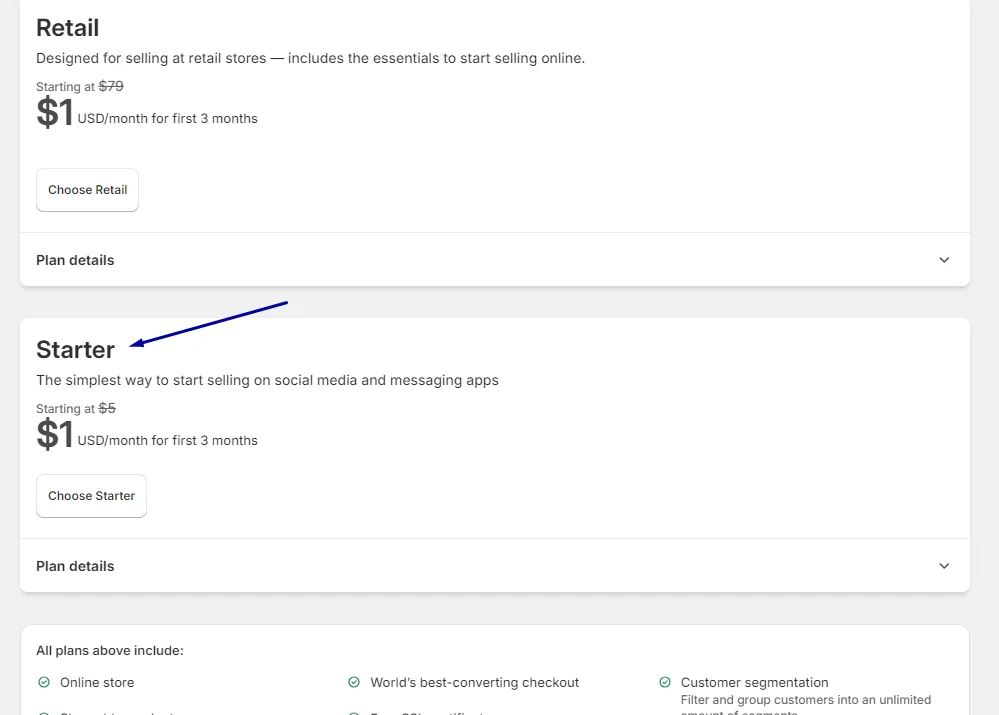
- Now, provide your billing address and then hit the “Subscribe” button.
Step 2: Customize your theme
Once you have successfully signed up for the Starter Plan, it’s time to fine-tune your Shopify theme.
The Shopify Starter plan provides a single default theme called “Spotlight.” To tweak this theme, first, head to your Shopify admin. Next, select “Online Store” > “Themes.” In the current theme section, hit the “Customize” button.
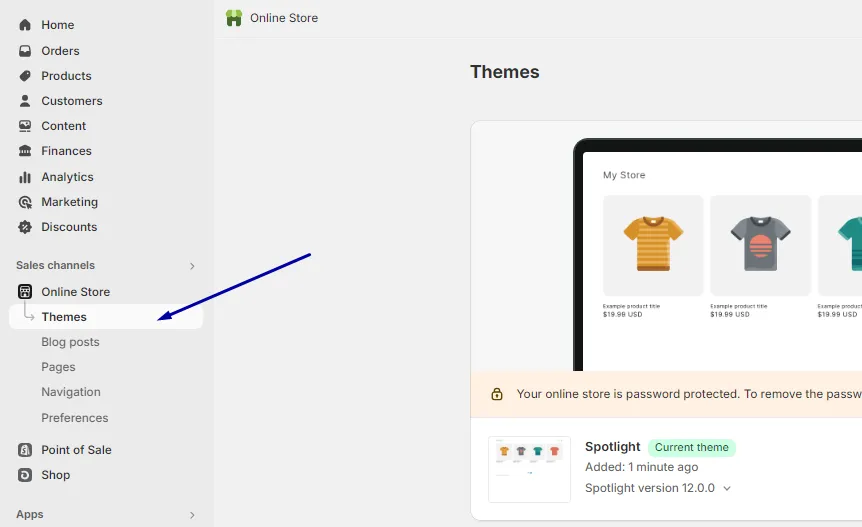
Once inside, you’ll find customization options on the left sidebar of the theme editor, such as:
- Logo
- Color scheme
- Crucial brand information: Headline, description, and image.
- Social media icons with clickable links
Noted: With the Shopify Starter plan, your store will have a Shopify subdomain (like myshop.myshopify.com). When visitors enter this URL, they’ll see your online storefront as shown below.
Step 3: Add Product Listing
To start selling with the Starter plan, you need to add your products to your Shopify Store. Here is how to do it:
Click “Products” in your Shopify Admin Panel to create and edit your product information.
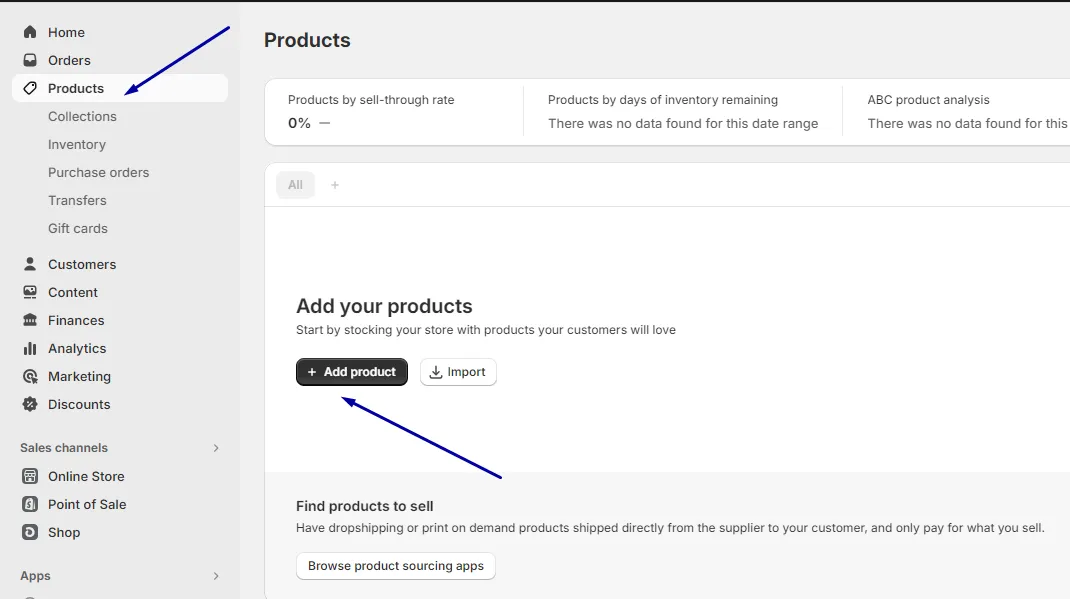
Once you are in, provide the following information:
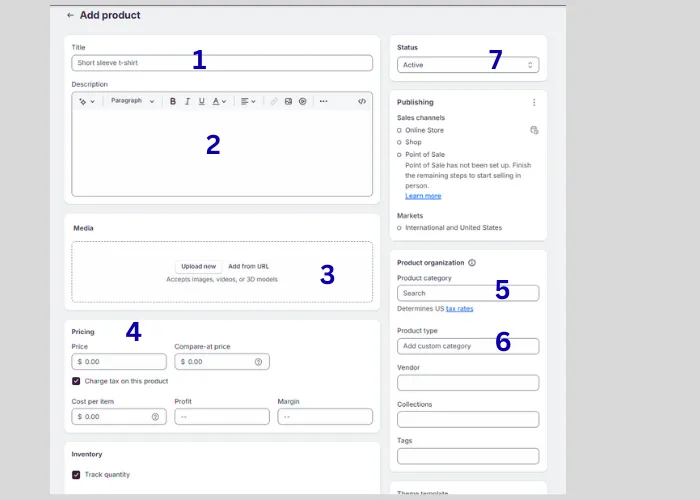
- Product Title
- Product Description
- Product Media (images, videos, or 3D previews)
- Pricing
- Product category
- Product Type
- Status “Active” or “Draft”
After that, hit “Save,” your newly added product is ready for the next step.
Step 4: Integrate with Social Media
To start selling on social media, you need to create a Linkpop landing page. To do it, go to “Linkpop” and sign in with a Shopify account.
Create your Linkpop Bio page.
- Click “Linkpop” in your Shopify Admin Panel and create your account.
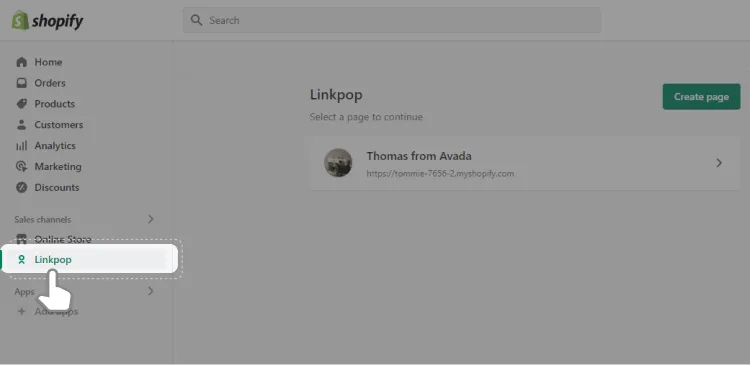
- Click on “Create page” to edit your Linkpop profile.
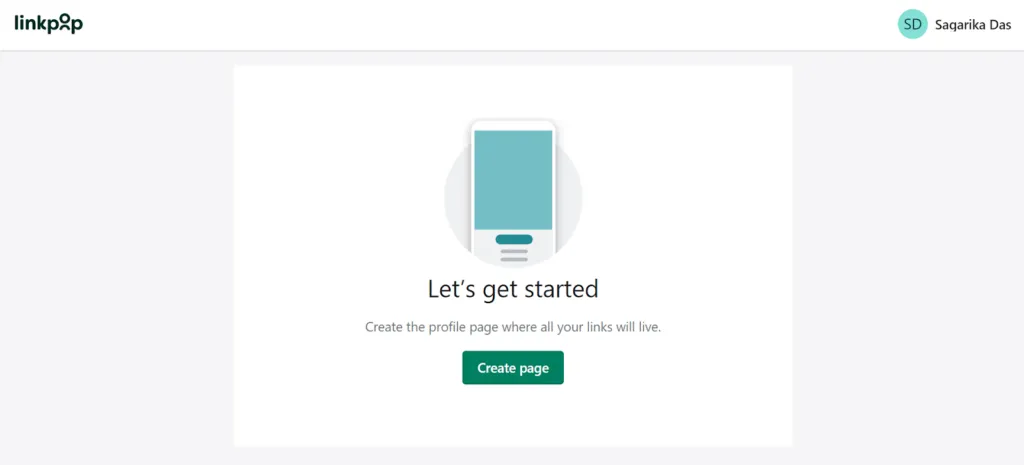
- Edit your Profile page URL, photo, name, and description, and click “Create profile.”
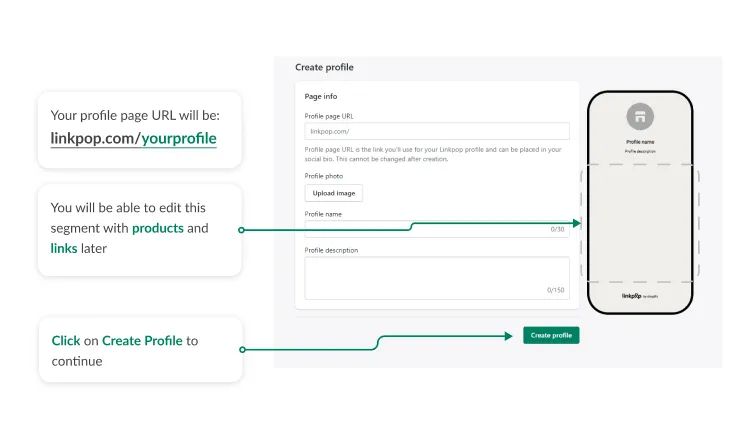
Add a Link to the Linkpop Bio Page
- On the Links tab, select “Add link.”
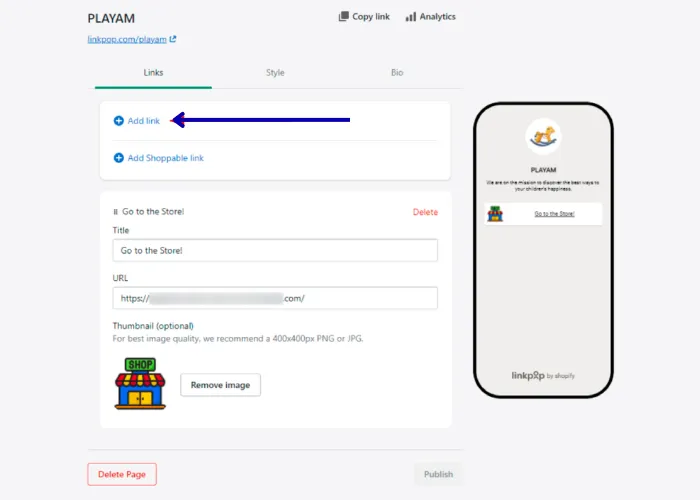
- Add the “Title” and “URL” for the new link
- Click the “Publish” button.
Add a product to your Linkpop profile
- Go to the Links tab and select “Add Shoppable link.”
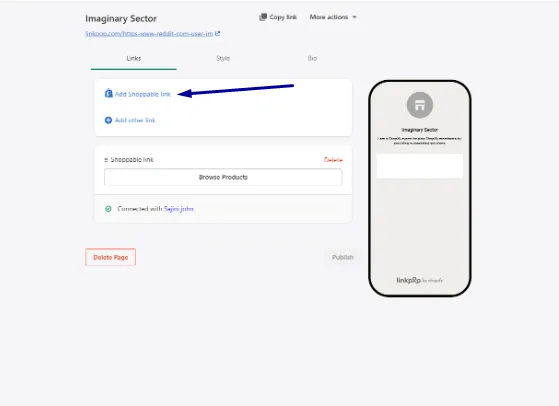
- Click the “Browse Products” button.
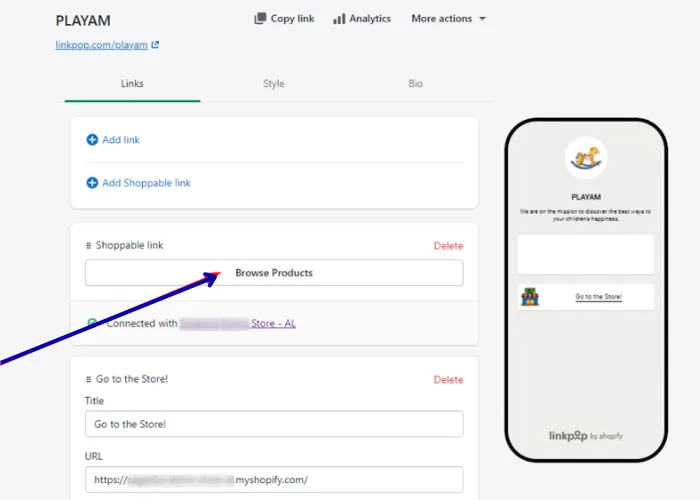
- Choose your desired products and then click “Select.”
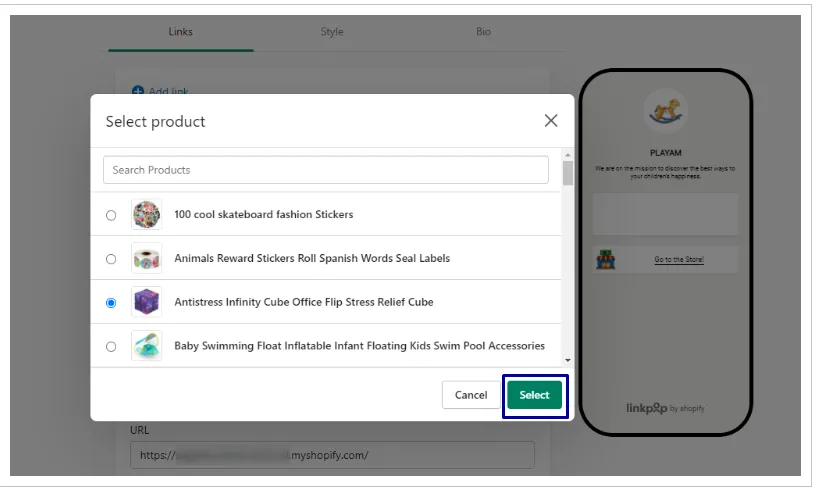
- After selection, click “Publish” to add the product to your page.
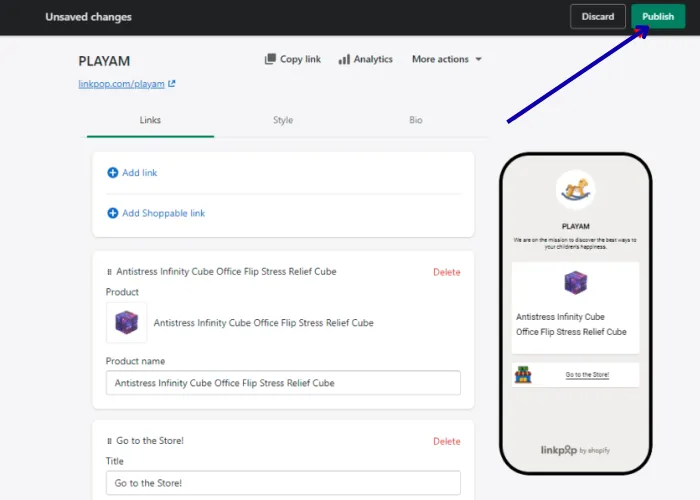
In this case, I will add the demo product: a Shopify-themed T-shirt!
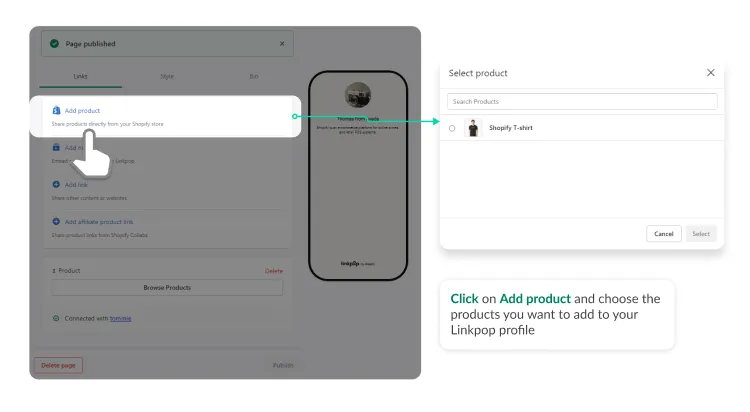
Here is an example of how the Linkpop page will look after adding one product.
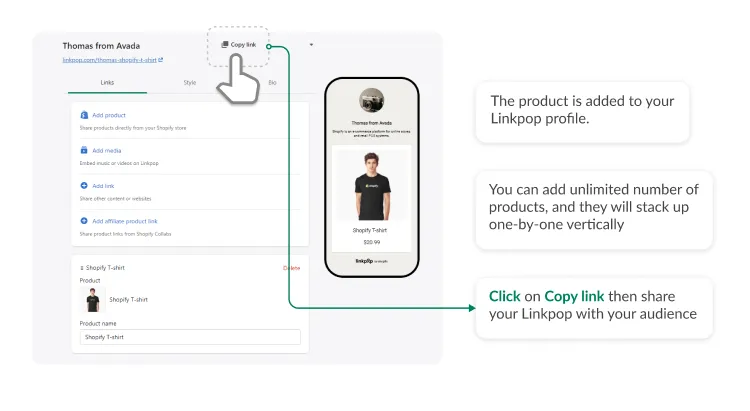
Step 5: Start Selling
Once you’ve added your products and created a Linkpop landing page, you can start selling them. There are two ways you can do this:
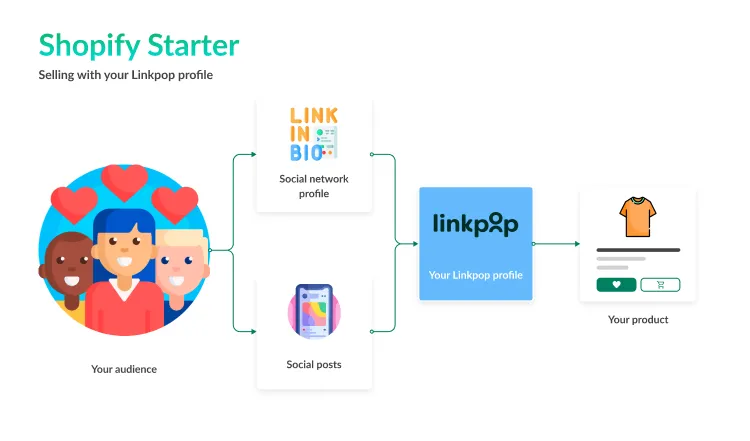
- Bio link: Add the product’s URL in your bios for Instagram, Tiktok, and Facebook

- Social Post: Use the Story feature on Instagram and Facebook to showcase your product with a link sticker.
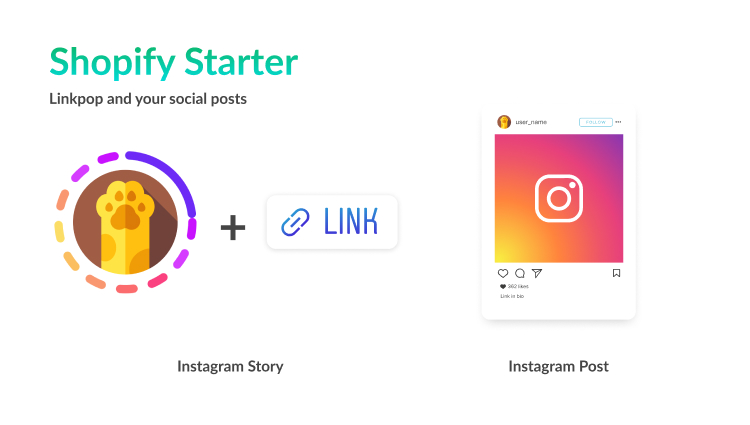
Shopify Starter Plan vs Basic Shopify Plan: Quick Comparison
Below is a comparison of the Shopify Starter plan and Basic plan:
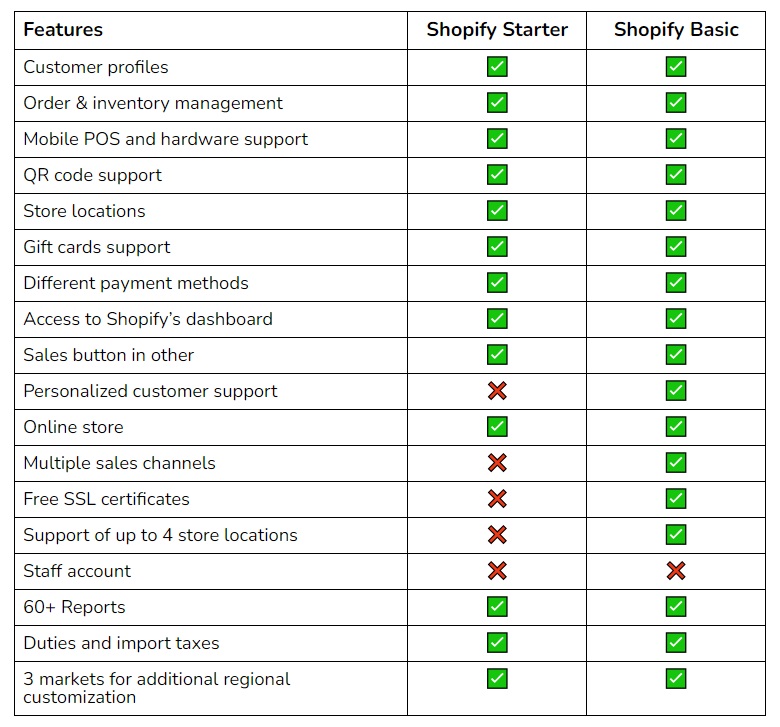
The Shopify Starter Plan offers a streamlined, cost-effective solution for selling on social media and chat platforms, making it perfect for beginners.
On the other hand, the Basic Shopify Plan provides a more robust e-commerce suite with a full website, advanced features, and enhanced analytics, ideal for growing businesses seeking a more substantial online presence.
For more information regarding the comparison of Shopify Starter Plan vs Shopify Basic Plan, please view the latest article HERE.
Shopify Starter Plan Examples: A Successful Case Study
- Industry: Food & Beverage

Steve Roeenfeldt, a YouTube cocktail creator, serves as a prime example of how the Shopify Starter Plan can propel entrepreneurs towards success.
His brilliant use of the Shopify Starter Plan to pre-sell his cocktail guidebook titled “Steve The Bartender’s Cocktail Guide” demonstrates the power of this platform in turning dreams into reality.
With its simple setup and effective sales features, the Starter Plan enabled Steve to seamlessly integrate sales into his social media, making it incredibly easy for his followers to purchase. Moreover, its $5 monthly affordability meant Steve could test the waters without heavy investment. His story is a testament to how the Shopify Starter Plan can be a game-changer for those looking to make their mark in the e-commerce world.
Read Steve’s full story here.
Upgrade to a higher Shopify plan from the Shopify $5 Plan Starter
Shopify merchants can upgrade to a better Shopify plan once their businesses have grown and expanded beyond the current package. These are the common upgrade choices to consider:
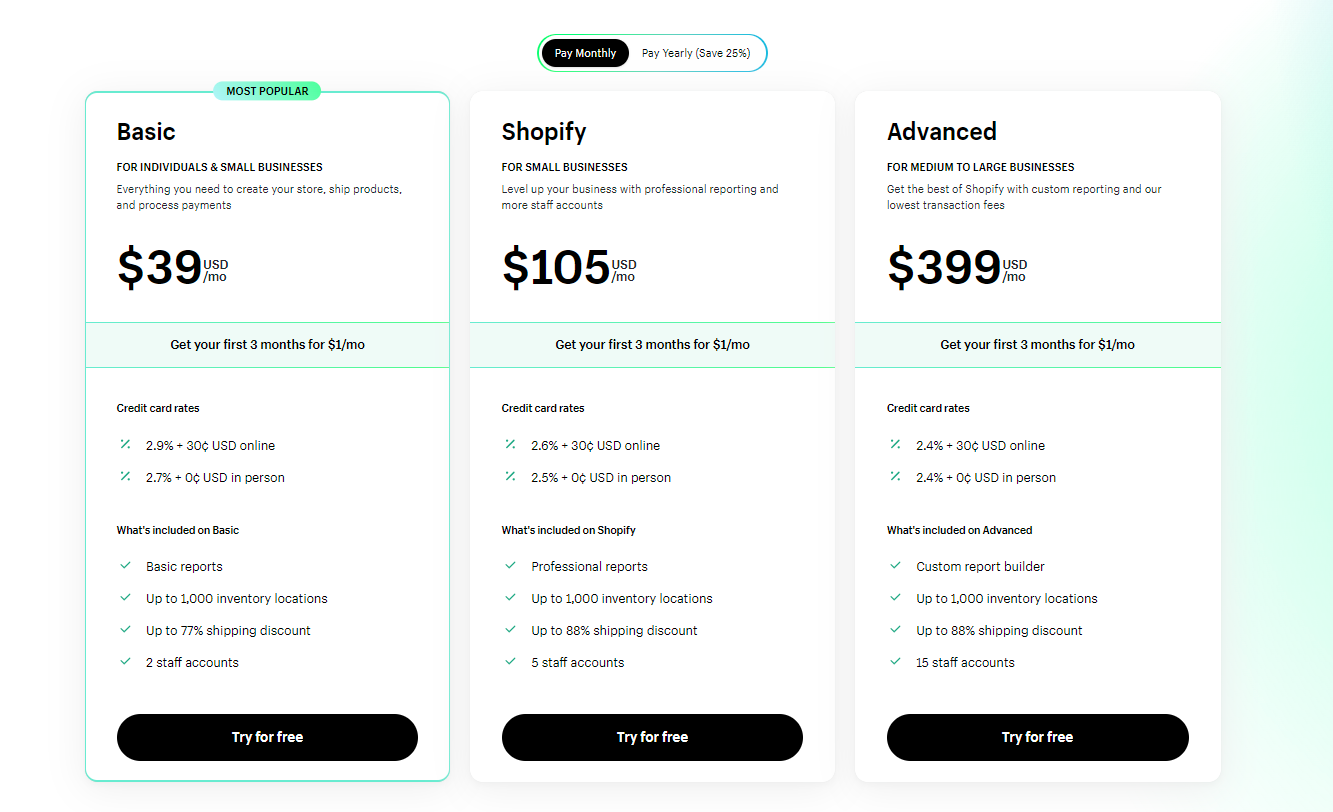
Shopify Starter Plan: FAQs
What are the limitations of the Shopify Starter Plan?
The limitations of the Shopify Starter Plan include:
No Full Online Storefront Limited Customization Restricted Sales Channels Basic Analytics Limited Marketing Tools No Staff Accounts Fewer Payment Gateways and Higher Transaction Fees
How much does the Shopify Starter plan cost?
The Shopify Starter plan is available for $5 per month and a 5% transaction fee for each sale made.
Can I use Shopify payments with Shopify Starter?
Absolutely, you can! The Shopify Starter plan comes with Shopify Payments, Shopify’s in-house payment gateway.
Can I use my own domain with Shopify Starter?
For the Shopify Starter plan, using your own domain isn’t typically necessary. This is because rather than providing an online storefront or homepage, it focuses on marketing and selling your products through social channels and messaging apps. Therefore, your own domain is not required to use the Starter plan effectively.
How do I change from Shopify Basic to Starter?
For now, it is not possible to switch from Shopify Basic to Starter. However, merchants can contact Shopify’s support team to cancel their current account and set up a new one with the Starter plan. If you wonder on how to check my shopify plan, refer to our latest blog HERE





